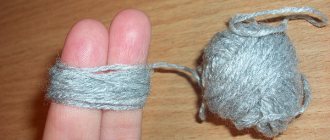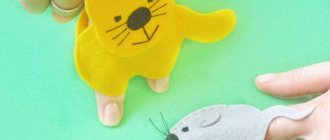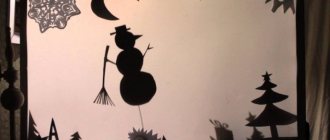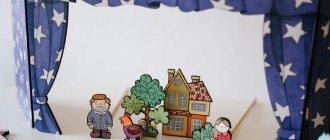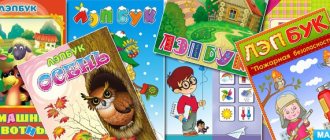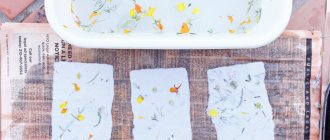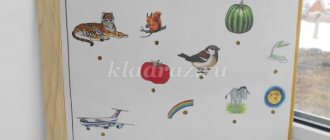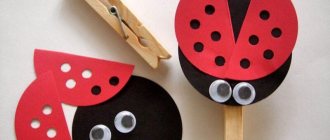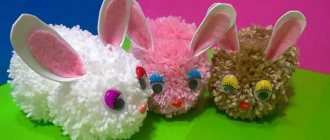DIY finger puppet theater
If you want to develop your baby’s fine motor skills, speech, thinking and simply be able to lift the mood of the whole family, then turn the room into a temple of art. To do this, you need to know how to make a finger puppet theater with your own hands.
For this you will need:
- felt;
- threads;
- scissors.
As you can see, the characters in the fairy tale “Turnip” are cut out very simply.
Each hero consists of two identical parts. But on one side you need to embroider facial features with threads. You can make them by cutting them out of dark felt and then gluing or sewing them on. Fold 2 character blanks with the wrong sides together, sew along the edge using a machine or with a thread and a needle on your hands.
To make a beard for your grandfather, wrap several rows of thread around your fingers and cut them on one side. Fold these identical threads in half and sew the beard in place.
And here’s what the heroes of the fairy tale “The Ryaba Hen” might be like. Cut out your grandfather's beard and bangs and grandmother's hair from gray felt. It will also help you create a mouse with a long tail. These are the kind of dolls you can sew for a puppet theater. If a baby will wear them, cut them so that they are the size of his fingers. If the performance will be performed for children by adults, then the fabric dolls should be slightly larger.
Check out another interesting idea. This could be a home puppet theater for staging the fairy tale “Turnip”. In kindergarten, it is better to have larger characters so that the whole group can see them from afar. But you can do something like this by taking:
- modeling paste (preferably Jovi, which does not need to be burned; it hardens in air);
- yellow and green paste Jovi Patcolor;
- acrylic paints;
- tassels;
- markers;
- stacks.
- Let's sculpt the grandfather first. Take a piece of pasta measuring 2x3 cm, roll it into a sausage, and form a cylinder. You should end up with something like a nesting doll with a body and head, and at the bottom there will be a notch for your finger.
- Separately sculpt the arms and attach them to the body. But outline the facial features, beard, and mustache using a stack.
- Using the same principle, sculpt the grandmother, granddaughter and animals. Once these characters are dry, paint them with acrylic paints.
- For the turnip, roll a ball of yellow paste, pull it out a little from the top, insert green plastic tops here, and secure.
When sculpting with paste, you will find that it dries quickly in the air, so periodically wet your fingers with water.
This is how you will get a finger puppet theater; with your own hands, a child will be able to act out the fairy tale “Turnip” or come up with his own plot with some of these characters.
Felt
You can create a puppet theater from felt with your own hands. For fairy-tale characters, multi-colored material is purchased.Characters are made from any materials, but it is better to buy thick fabric. If the chosen option does not hold its shape, use doublerin.
The pattern is made according to the hand size of the person who will perform the performances for children. You can use mittens as a base. Be sure to allow seam allowances. The parts must be sewn by hand or by machine.
Now you need to make the head. Its size depends on the personal wishes of the master. Two circles are sewn together. The head is shaped using filler. Cotton wool and padding polyester are suitable for this.
The same pattern is used to make tails and paws for animals or pets. Now you need to draw a face, glue ears and hair. The eyes will become beads or buttons.
DIY table theater
If you want to have a tabletop theater with paper dolls, then enlarge the following image. Print it on a color printer on thick paper. If this is not possible, attach a sheet of thin paper to the screen and transfer the outlines onto it. Then place it on cardboard, draw outlines, and let the child decorate the characters with colored pencils or paints. All that remains is to cut out the images, glue each on the side and glue the top of the head to the head.
And here are some more templates that can be used to easily make theater dolls. With your own hands or by giving the blanks to your child, cut them along the contours and glue them in pairs. If a small rectangular sheet of colored paper is glued on the side, you get a small tube. It should be such that it fits well on your finger. Glue the ears, nose, eyes, front paws to the blank, and you will get a finger puppet theater hero. These characters can be made from the most unexpected materials. See how to turn plastic spoons into stage plays. To make these toys for the puppet theater, take:
- plastic spoons;
- colored paper;
- scissors;
- ready-made plastic eyes;
- glue gun;
- textile;
- narrow tape, scissors.
Next follow these instructions:
- Using a glue gun, glue the finished eyes to the convex side of the spoon.
- Turn a piece of fabric tied with a ribbon into a dress. For a male character, just glue a bow tie to his neck.
- Cut strips of colored fringe paper on one side and glue this hair. They will also be replaced by pieces of colored cotton wool.
That's it, the children's puppet theater at home is ready.
Take a large cardboard box, cover it with colored paper, and turn it over. Make slits in the bottom with a knife, insert spoons here and move the dolls along these holes, like along a path. Other characters are controlled in the same way, to create which you will need:
- ice cream sticks;
- children's magazines;
- glue;
- scissors.
Let the child cut out pictures of people and animals from a magazine or an old book and paste them on sticks. If you want to make another tabletop theater, then milk bottle caps will come into play. Plastic yogurt cups. Glue paper fairy tale characters to the back of these items, and you can play out old stories with them or invent new ones. The background is created from a large sheet of cardboard, which is painted to match the theme.
Paper figures
Just make heroes out of cardboard. You can use colored paper. You can choose any product sizes. Kids will love creating a paper puppet theater with their own hands.
If a fairy-tale hero breaks, it’s easy to replace it with a new one. You will need special templates that need to be cut out. Two parts of one character are glued together.How to make a screen for a puppet theater?
This is an essential attribute of puppet theater. Check out the simplest options:
- Cover the hole under the table with a cloth, tying its two corners to the top of one and the other leg. The child sits on the floor behind him and leads the characters at the level of the table top - just above it.
- Take an old curtain or sheet. Gather any of these fabrics onto a rope, tie the ends of the thread on one and the other side of the doorway. Make a rectangular cutout in the center of the top of any of these pieces. It should be at such a height that it is not visible to a child or adult sitting behind the curtain who are playing the role of puppeteers.
- A tabletop screen is made for the finger theater. The easiest way is to make it from cardboard. Take the box. It needs to be disassembled, covered with wallpaper or colored paper, and 2 sides bent so that a canvas of sufficient size remains in the center. There is a cutout in it through which the puppeteer shows finger toys.
Here's how to make a plywood screen. For it you will need:
- plywood;
- jigsaw;
- fabric or piece of wallpaper;
- glue;
- small door hinges.
Manufacturing instructions:
- Based on the presented dimensions, cut out 3 blanks from plywood: a central one and 2 side panels. Cover them with fabric.
- When the canvas is dry, attach the loops to the designated areas so that you can close the puppet theater screen and fold it.
See how to make a screen out of cardboard so you can show performances with mitten, glove, and cane puppets.
It should be such that the puppeteer can fit there freely, standing up to his full height. If the performance is performed by children of different ages, then the tall ones will kneel, placing a pillow under them. In order to make a screen, you will need:
- PVA glue;
- rope or lace;
- carton boxes;
- wallpaper;
- stationery knife;
- awl;
- roulette;
- wide brush;
- long ruler;
- rag.
You can make a screen for a puppet theater with your own hands as follows:
- The drawing is given for teenagers or adults whose height is 1 m 65 cm. If you are making a screen for children, reduce this figure.
- To make it durable, make it three-layer. To do this, stick a second one on one large sheet of cardboard, then a third one on the other side. Apply PVA glue with a wide brush. This way you will make the front part - the apron.
- The side elements are also made in three layers, but the folds, which you then glue to the apron, should consist of one layer.
- Connect the parts by gluing them. When the glue has dried, sew in these places with a lace, having previously made holes in the fastening points. Attach the top arch in the same way.
All that remains is to cover the screen with wallpaper of a dim color so that it does not distract from the theatrical performance.
Creative workshop “Theater on Spoons”
Theatrical activity is the most common type of children's creativity. It is close and understandable to the child, it lies deeply in his nature, because it is closely connected with play. Entering the character, he plays any role, trying to imitate what he saw and what interested him.
This year, the idea came up to create a new type of theater, which we did not have in the preschool department yet. This is "Theater on Spoons".
Spoon theater is a simplified version of riding puppets. They are based on a wooden spoon, light and easy to handle. On the convex side of the spoon they draw the character’s face (the face of a fox, wolf, bear, bun, etc.). You can glue ready-made ones. Every spoon (now a theatrical character). The child takes the spoon by the handle and lifts it onto the screen. Such a spoon doll can easily move across the screen, sway, turn in different directions, and dance. The stage of making theatrical puppets and scenery with the involvement of children is very important. It is interesting, educational for them, also promotes the development of speech and imagination, and activates constructive abilities.
Preparation for the lesson consisted of several stages:
At the last stage, the children are shown techniques for driving spoon dolls.
Main goal of the lesson:
During the lesson, children are presented with a problem situation, which they solve with the help of assigned tasks:
Progress of the lesson
Educator: Guys, what plans did you and I have for today?
Children: answers (We planned to show the puppet theater to the children from the younger group).
Educator: Come on, take the dolls, you will now decide who will play what role and then we will show the fairy tale to our kids.
The guys open the box where the dolls are, and there they find a torn scarf and a note.
The note reads: “Turn on your magic box and listen to what I tell you. Baba Yaga."
Educator: Well, guys, let's turn it on and see what she sent us?
Video message B.Ya.: Well, killer whales, you wanted to show the kids a fairy tale, do a good deed? But you won't succeed! Do you know why, I enchanted your dolls and turned them into one object. To find out what this object is, you must guess my riddle:
“I look a little like a spatula, I look a little like an oar, I help the kids eat porridge, and my sister is a cook.” Children's answer: spoon.
Baba Yaga: “In my box you will find spoons. Think about what needs to be done to make the spoons turn into dolls again?”
Educator: What should I do?
Children's answers: We need to make new dolls
Educator: Guys, if you take an ordinary spoon, attach a face, pigtails and a bow, an elegant dress or animal faces and ears to it, you will get a doll.
On the table are various parts of animal faces and costumes that you and your parents made in the last lesson, and now we will make new dolls for our fairy tale.
We make do-it-yourself glove dolls
These can be seen in a real puppet theater. Dolls put gloves on their hands. By bending your fingers, you can make the fabric character tilt its head and move its arms.
Children's puppet theater will have many characters if you use the proposed template. But it is not necessary to create all the heroes at once. Let's start with two - bunnies and piglets. Having understood how to make such doll gloves, you will be able to sew others, thereby gradually replenishing your theater.
If you then make human dolls, you can make the hairstyle from fabric or thread.
The thickness of the character's neck should be such that the puppeteer inserts his middle and index fingers here to control the hero of the play.
Before sewing puppets for the theater, place a puppeteer's glove on the re-cut pattern to decide whether the base is suitable. If not, then increase or decrease it. You can do without a glove by placing the puppeteer’s hand on the base pattern. Please note that the character will not be static, so you need to add a little on all sides for a loose fit so that the fabric of the action hero does not stretch while controlling him.
So, here's what you need to sew a glove doll:
- faux fur and/or plain fabric;
- tracing paper or transparent paper or cellophane;
- pen;
- scissors;
- threads;
- buttons for eyes.
Enlarge this pattern.
Attach a transparent material (cellophane, paper or tracing paper) to it and redraw it. Cut along the outline. Place the pattern on the fabric folded in half, cut with a 7 mm seam allowance. For a bunny it is better to take gray fabric or white fur, for a pig - pink. If you want to draw facial features, tails, hands, hooves, then do it now, before sewing both halves of each character. Take special fabric paints that do not fade when washed. If there are none, then use watercolor, gouache, but first apply a PVA solution to the fabric, after it dries, paint this place, but use a minimum of water. When the paint is dry, add another layer of PVA on top to secure it. But it is best to embroider the nose and mouth by stretching these areas onto a hoop or sewing blanks of appropriate colors and eye buttons.
Cut out a shirtfront from white fur for the bunny glove doll, sew its triangular part to the front half, and the semicircular part, in the form of a collar, to the back half. The tail is attached to the same reverse side, and white paws with or without pink claws are attached to both parts.
When small parts are sewn on, you can sew both halves of the doll on the inside out using a machine or on the face using your hands. In the latter case, use an over-the-edge seam or take a tape of a matching color and edge the side seam with it.
Other glove dolls, for example, a pig, are also created using this technique.
When the sides are stitched on all sides, hem the bottom. The characters' ears can be stuffed with cotton wool or padding polyester. Fill the pig’s nose with any of these materials, only after that sew this “patch” to the head. Applique it on his cheeks, giving them a blooming look. It remains to sew a few yellow threads between the ears, and another glove doll is ready. Now you know how to sew characters for a puppet theater, if you want to see this too, then watch the following stories.
Pedagogical project
"Theater of Plastic Spoons"
Educator:
Project topic: Preparing characters for dramatization of a Russian folk tale
"Teremok" for showing a puppet theater made from disposable plastic spoons.
Project type: children's, short-term
Project participants: teacher, senior children, parents of students.
Relevance of the topic:
The most popular and exciting area in preschool education is theatrical activities. From the point of view of pedagogical attractiveness, we can talk about the versatility, playful nature and social orientation, as well as the correctional capabilities of the theater.
It is theatrical activities that make it possible to solve many pedagogical problems related to the formation of the expressiveness of a child’s speech, intellectual and artistic-aesthetic education. By participating in theatrical games, children become participants in various events from the lives of people, animals, and plants, which gives them the opportunity to better understand the world around them. At the same time, theatrical play instills in the child a sustainable interest in his native culture, literature, and theater.
The educational value of theatrical games is also enormous. Children develop a respectful attitude towards each other. They learn the joy associated with overcoming communication difficulties and self-doubt. Children’s enthusiasm for theatrical play, their inner comfort, relaxedness, easy, non-authoritarian communication between an adult and a child, the “I can’t do it” complex disappears almost immediately - all this surprises and attracts.
Fairy tales serve as the first lesson for children about morality and ethics by which people live. This sets the child up for an optimistic perception of life, develops positive character traits and social behavior skills. Work on the theatricalization of a fairy tale contributes to the development and correction of all mental cognitive processes. Learning the words of a fairy tale helps develop memory, expand vocabulary, automate sound pronunciation, and expressiveness of speech. Thus, work on the theatricalization of fairy tales contributes not only to the replenishment of knowledge and skills, but is a means of developing general gaming skills, speech, personal qualities of the child, and his adequate behavior in various situations.
Goal: to prepare the necessary equipment and material for the staging of the Russian folk tale “Teremok”
- To promote the development of dialogic and monologue speech, to develop the ability to pronounce words clearly and clearly, and to develop intonation expressiveness. Develop the ability to imitate the characteristic actions of characters. Involve parents in family reading of Russian folk tales and help in the creation of characters and attributes for fairy tales.
Project implementation stages.
Preparatory stage.
- Exhibition of books of Russian folk tales in the book center. Selection of visual teaching aids and illustrations for fairy tales. Acquisition of the necessary equipment and material for the creation of the Russian folk tale “Teremok”.
Main stage.
- Reading a fairy tale with parents at home and with the teacher in kindergarten. Listening to a fairy tale in an audio recording; viewing . Retelling a fairy tale using a tabletop theater Manual labor - making fairy tale characters with children and parents from scrap material (plastic spoons)
The final stage.
- Showing the Russian folk tale “Teremok” for children of other groups. Conversation with children (What happened? What did you like? etc.) Conversations with parents and their feedback on the children’s show of the staged puppet fairy tale “Teremok”
“Development of event content with parents”
Master class “Do-it-yourself spoon theater”
Form of delivery: master class.
Audience: middle school parents.
1. Increase the pedagogical competence of parents in matters of education and development of preschool children.
2. To develop skills of interaction with a child at different stages of his development.
3. Contribute to increasing the effectiveness of interaction between parents and preschool educational institutions.
4. To form parents’ ideas about the importance of theatrical activities for comprehensive education.
5. Learn to make riding dolls from spoons.
Expected results:
Increasing the pedagogical competence of parents in matters of education and development of preschool children.
Formation of skills to interact with a child at different stages of his development.
Increasing the effectiveness of interaction between parents and preschool educational institutions.
Formation of parents' ideas about the importance of theatrical activities for the comprehensive development of the child.
Making riding dolls from spoons for the fairy tale “Zayushkina’s hut.”
Information and technical support: projector, tape recorder.
Materials and equipment: 7 unpainted wooden spoons; acrylic paints; brushes; textile; braid; pieces of fur; animal caps for the dramatization of the fairy tale “Teremok”; puppets for different types of theater.
Logic of implementation.
1. Game with a parachute “Dash”.
Goal: promote group cohesion. (Annex 1) .
2. Message from the teacher “The importance of theatrical activities for the comprehensive development of the child.”
Goal: to form parents’ ideas about the importance of theatrical activities for the comprehensive development of the child.
(Appendix 2) .
3. Survey of parents “What types of theater do you know?”
(Appendix 3) .
4. Message from the music director “Types of theater in kindergarten” followed by a show of puppets.
Goal: to introduce parents to the types of puppet theater in kindergarten. (Appendix 4) .
5. Master class on making dolls from wooden spoons.
Goal: learn to make riding dolls from spoons. (Appendix 5) .
6. Parents dramatize the fairy tale “Teremok” with musical accompaniment.
7. Summing up. Final message from the teacher.
(Appendix 6) .
Annex 1.
Game with a parachute "Dash".
Goal: promote group cohesion.
Progress of the game: parents stand holding the colored sector. They raise and lower the parachute with the words: “We’re tired of standing, we need to run across!” »
At the leader’s signal: “1, 2, 3 – blue (any other color) run! "- those who stand in the sector of the named color run across under a parachute and change places.
Appendix 2.
The importance of theatrical activities for the comprehensive development of a child.
In modern society, the social prestige of intelligence and scientific knowledge has increased. Associated with this is the desire to give children knowledge, teach them to read, write and count, but little attention is paid to the ability to feel, think and create.
In addition, recently children have been fascinated by computers and other newfangled toys, with which parents are trying to replace their peers, protecting the child from troubles, from “bad influences”; adults are also trying to fill the lack of children’s community, help and participation of adults in the development of the child, Without this, full mental and emotional development of the individual is impossible.
The shortest path to a child’s emotional liberation, relief from constriction in learning, feeling and artistic imagination is the path through play, fantasy, and writing.
The solution to these problems is theatrical activity.
The importance of theatrical activities in the development of a child can hardly be overestimated, since theatrical art occupies a special position among other types of arts due to the possibility of a direct emotional impact on a person.
According to researchers (, and others, theatrical activities allow solving many pedagogical problems, especially speech, intellectual, artistic and aesthetic development and education of children; it is an inexhaustible source of development of emotions and feelings, a means of introducing a child to spiritual values, and performs a psychotherapeutic function .
Theatrical activity, being a type of game, is initially synthetic in nature: it is a literary text and the sounding word, the plasticity and actions of the actor, his costume and the visual space of the stage (light, color, music, etc.).
Thus, children's theater allows the teacher to solve problems not only of an executive nature, but also cognitive, social, aesthetic, and speech.
Appendix 3.
Parent survey “What types of theater do you know?”
Goal: to identify parents’ ideas about types of theater.
What types of theaters do you know?
What types of puppet theater do you know?
Do you think it is possible to make theatrical puppets at home?
Appendix 4.
Types of theater in kindergarten.
Puppet theater is a magical world - one of the greatest models of Man and Humanity. Unlike drama theatre, where live people play instead of puppets, puppet theater is more durable. Its actors are capable of living for many centuries, and any museum doll, guided by the hand of an experienced puppeteer, at any moment is capable of coming to life and playing in front of us the same puppet comedy that was admired by the audience - kings, artisans, nobles, merchants, hired soldiers - and a hundred and two hundred and four hundred years ago.
There are several classifications of puppet theater games for preschool children:
tabletop puppet theater: theater on a flat picture, on circles, magnetic tabletop, cone, toy theater. (The music director tells an excerpt from the fairy tale “Turnip” using a cone theater).
stand theater: flannelgraph, shadow, magnetic stand, stand-book. (The music director tells an excerpt from the fairy tale “The Tale of the Stupid Mouse” using a flannelgraph).
theater on the hand: finger, pictures on the hand, mitten, glove, shadow. (The music director tells the nursery rhyme “Cockerel, cockerel” using a cockerel mitten).
floor dolls: marionettes, cone theater.
living puppet theater: theater with “living puppets”, life-size puppets, human puppets, mask theater, Tanta Moreschi. (The music director recites A. Barto’s poem “I Love My Horse” using a life-size puppet - a girl).
riding dolls: on gapit, on spoons, bibabo, cane. (The music director tells an excerpt from the fairy tale “Zayushkina’s Hut” using a doll on a spoon).
Appendix 5.
Stages of making dolls from wooden spoons.
1. On the outside of the spoon, draw a person’s face or an animal’s muzzle.
2. Decorate with braid, pieces of fur, and ribbons.
3. Sew a skirt out of fabric and put it on a spoon.
4. Tie the skirt tightly at the “neck” of the spoon.
Appendix 6.
Final message from the teacher.
Dear parents! Today you learned about the importance of theatrical activities for the comprehensive development of a child, got acquainted with types of theater that can be used in joint games with children, and also learned how to make dolls from spoons yourself, and tried yourself as an actor.
We hope that all this will help you spend time together in an interesting and beneficial way for your child’s development.
After all, with the help of playing theatrical games together, you can easily and naturally form the correct model of behavior in the modern world, improve the child’s general culture, introduce him to music, fine arts, etiquette rules, rituals, and traditions. Then the love for the theater will not only become a vivid childhood memory, but will also remain a feeling of celebration from the time spent with you in the unusual magical world of the theater.
We wish you good luck!
Theater! How much he means to a child’s heart, how impatiently children look forward to meeting him! The art of puppet theater is folk in nature.
Dolls can do everything or almost everything. They work wonders: they entertain, teach, develop the creative abilities of preschoolers, and correct their behavior. Children are happy to join in the game: answer the dolls’ questions, fulfill their requests, give advice, and transform into one image or another. They laugh and cry along with the dolls, warn them about dangers, and are always ready to help their heroes. How can you make the joy of communicating with them become daily? We need to create a puppet theater in kindergarten and at home! Children are introduced to puppet theater from the 1st junior group. Educators and older preschoolers show small performances to children, using various types of theaters for this purpose: the well-known picture theater (flannelgraph, parsley theater, in which glove puppets are occupied. With great pleasure, children watch the figures moving on a brightly lit screen. The shadow theater is riveting their attention, develops the ability to concentrate. Theater on the table is the simplest and most accessible theater for all ages of children. The torso of the dolls is made in the form of a cone, to which the doll's head and arms are attached.
By the end of the year, children of the 1st junior group, having accumulated some experience, try to independently participate in a puppet show. This desire must be supported, developed and strengthened. A finger theater is suitable for this purpose.
Mitten dolls were born from ordinary knitted mittens. The imagination of teachers and children can turn the most ordinary mittens into animals and people. They are very easy to operate and are intended for very young children.
For children of the 2nd junior group, the simplest and most accessible theater is a puppet theater on a table. You can use different types: “disc” theater, three-dimensional toys made of cylinders and cones, boxes of different heights. Origami theatre, mug theatre, lollipop theatre, kinder theatre, washcloth theatre, magnet theatre. Glove puppets are very mobile and expressive. Glove puppets can be used as funny assistants in kindergarten classes. Bibabo dolls usually operate on a screen behind which the driver is hidden.
In the middle group we move on to more complex theater. We introduce children to theater screens and cane puppets. These dolls are larger than glove dolls (head size can be up to 20 cm). This doll is raised above the screen with the help of a rod inserted inside, which is called a "gapit". Canes are attached to the doll's hands - sticks, which the puppeteer moves. But before staging a play with these dolls, you need to give children the opportunity to play with them. The Spoon Theater, being a simplified version of the performance with the participation of riding puppets, helps children master puppeteering techniques.
My dolls turned out to be very cute, strong and attractive.
Materials:
A set of spoons, cardboard, any fabric, woolen threads, felt or other material, ribbons and eyes.
Preparation method:
Hair. We use wool threads to make pompoms. They are instantly glued with glue to the inside of the spoon. Thread colors can be completely different. For the grandfather doll, we used a ready-made pompom and a dress from a New Year's hat.
Cloth. It’s better, of course, to sew a dress - a felt cone, then you won’t have to hem it. But you can also use other fabrics, preferably dense, to keep their shape.
We sew the cone together and make a cut in the upper part, just below the corner. We insert a spoon into the cut and tie it tightly with a ribbon, maybe with a bow.
Eyes. You can draw eyes on the spoon, stick on ready-made running eyes, or make them.
In my case, it turned out to be such a bright royal family.
Have you ever eavesdropped on children playing? If yes, then you know that children are amazingly artistic creatures. Mom’s and dad’s intonations are easily distinguishable, scenes from everyday life are recognizable... Transformation is a child’s second nature. He tries on different roles and plays them brilliantly. Inspire a young actor to experiment creatively and give him a puppet theater!
As always, we will use available materials, and the little artist himself will participate in the creation of his own theater.
Dolls made from... spoons
Bright and unusual theatrical dolls can be made from disposable spoons in half an hour. By the way, such toys are an ancient tradition; our ancestors painted and even decorated wooden spoons.
You can choose a fairy tale to make a doll set especially for. For example, the fairy tale “Turnip”.
You will need:
Disposable spoons (10-20 pieces); hot gun and glue; scissors; markers; yarn of different colors; accessories (buttons, beads, small parts).
First you need to think through the details for each doll.
For grandfather, for example, you can use gray yarn to make hair, eyebrows and mustaches, a large bead for the nose, dark fabric for clothes. You can simply draw the eyes with a marker or glue store-bought ones.
To make doll hair, wind the threads around two fingers, remove the skein and tie it in the middle with thread of the same color. Cut the loops, trim the ends. Apply hot glue to the back (in this case concave) side of the spoon and glue on a bunch of threads. We also glue on the mustache and nose.
Grandfather has a double body - a second spoon is glued to the base spoon, masking the underside. To do this, drop glue onto the top of the cutting and connect the parts.
Wrap a piece of fabric around the handle of the spoon so that it sits loosely (to add volume to the body). Tie fabric clothing, disguise this place with decorative tape.
To make a hairstyle for your grandmother, you need to wind a thread around your palm, make two bunches, and glue them on the concave side of the spoon on the sides (attachment points are marked with black dots). After the glue has hardened, lift the strands up and tie them in the form of a bun. We wrap long strands around the bun and secure with thread of the same color. (Since the grandmother’s hairstyle is voluminous, the second spoon (the back part) may protrude and lie sloppily.)
A turnip can be made from a spoon and from half a Kinder Surprise box. First you need to cut an oval piece of fabric of such a size that it can easily decorate the front part, and still be enough to overlap the back part and secure it. The fabric is attached from the back (concave) side with hot glue. After all, the turnip head is attached to the spoon.
The turnip may have eyes, a mouth painted with red varnish, and on the top of the turnip’s head there may be a bun decorated with a ribbon.
You can give your granddaughter a more “free” hairstyle, and make the dog’s ears and tongue from the remains of a rubber glove or pieces of fabric.
Cone finger puppets
These dolls are relatively fragile - they cannot be crushed, and their strength is not the same. But cone dolls are very funny and dynamic, because wolves and bears sit right on the tips of children's fingers.
You will need:
Colored paper; PVA glue; scissors.
You can also choose which fairy tale heroes to make. For example, “Teremka”: a mouse, a frog, a hare, a fox, a wolf and a mischievous bear.
Cut a circle with a diameter of 13 cm into 4 equal parts. One of these quarters will be the template for the base of the toy. The rest is a different set of details for each character.
The workpiece must be rolled up and glued.
Glue the remaining parts - ears, eyes, whiskers, paws, tails, etc. to the finished body. You can curl your mustache using a pencil or using a scissor blade.
"A Tale Told by Wooden Spoons." Musical educational game
Galina Makarova
"A Tale Told by Wooden Spoons." Musical educational game
"A Tale Told by Wooden Spoons"
Musical educational game.
1. Development of rhythmic hearing
2. Securing the game prims on wooden spoons
3. Development of imagination
Guys, today we will hear a fairy tale. Yes, not simple, but musical. And her wooden spoons will tell us. Only they need your help. Shall we help?. (teacher hands out spoons to children)
. Listen to the story carefully and repeat the rhythmic patterns after me.
Once upon a time there lived a grandfather and a woman. One autumn day they were sitting on a bench and gossiping. Then the grandfather will tell the news in the woman’s ear (knocks near the left ear: ti-ti-ta-ta-ta)
, then the woman to the grandfather (
knocks near the right ear: ti-ti-ta-ta-ta).
So they started wagging their tongues
(the dance song “Oh, you canopy” sounds), the children repeat the rhythmic pattern several times).
Their favorite chicken walked next to them and pecked grains (to the music, the tip of the handle of one spoon is hit on the back of another spoon: ti-ti-ti-ti-ti-ti-ta).
But then she pecked the last grain and flapped her wings indignantly, clucking (the “plates” are knocking)
The woman says to the grandfather: harness the horse and go to the field to harvest the grain. The grandfather got into the cart and the horse galloped (spoons together, finger between them, hit on hand, on knee).
As soon as the grandfather arrived at the field, the rain began to pour (they knock the handle of one spoon against the handle of another)
The grandfather began to knock on the old stump, scare the cloud, drive it away (one spoon is upside down, the other is beaten on it: ta-ta-ti-ti-ta).
The cloud got scared and flew away. And the sun floated into the sky (“they draw” a circle with spoons).
Grandfather removed the wheat, threshed it on the threshing floor and took it home (spoons together, finger between them, hit on hand, on knee).
How happy grandma and the chicken were with him! They praised him, they praised him.
This is the tale the spoons told us.
(all rhythmic patterns are played to Russian folk music of the appropriate nature)
Didactic game “Fairy tale or true story?” Why do we need fairy tales? What does a person look for in them? Maybe kindness and affection. Maybe yesterday's snow. In a fairy tale, joy wins, Fairy tale. Didactic game-fairy tale “About hands - right and left” Experience shows that many preschoolers for a long time do not confidently navigate space and confuse their right and left hands. S. Didactic musical game “Snowmen” Today I bring to your attention the musical and didactic game “Snowmen” that I made. An analogue can be called the game “Fun and Sad”. Musical didactic game “What are they doing in the house?” Goal: To develop timbre perception in children and improve their sense of rhythm. Help deepen children's understanding of tools. Musical fairy tale "Cat's House" Musical fairy tale "Cat's House" 1 SCENE. (Folk music) (The buffoons dance, then speak loudly, invitingly) 1 buffoon: Tili-tili-tili-bom.
Source

